International Intellectual Property Law and Competition Law in the EU
VerifiedAdded on 2020/05/04
|15
|3580
|46
Essay
AI Summary
This essay examines the intersection of competition law and intellectual property law within the European Union. It begins by outlining the relationship between these two areas, emphasizing how competition law aims to promote efficiency and maximize welfare while intellectual property law grants exclusive rights to authors and inventors. The essay highlights the differences in application between the EU and the United States, particularly regarding patent rights and trademarks. It then delves into specific issues such as refusals to supply essential inputs, parallel imports, and conduct by copyright collectives, providing a detailed discussion on the impact of intellectual property rights on market segmentation, price discrimination, and the exhaustion of rights. The essay also considers the role of the European Court of Justice in managing the tensions between these legal frameworks, including the treatment of goods originating outside the European Economic Area and the partitioning of the EU into national markets.
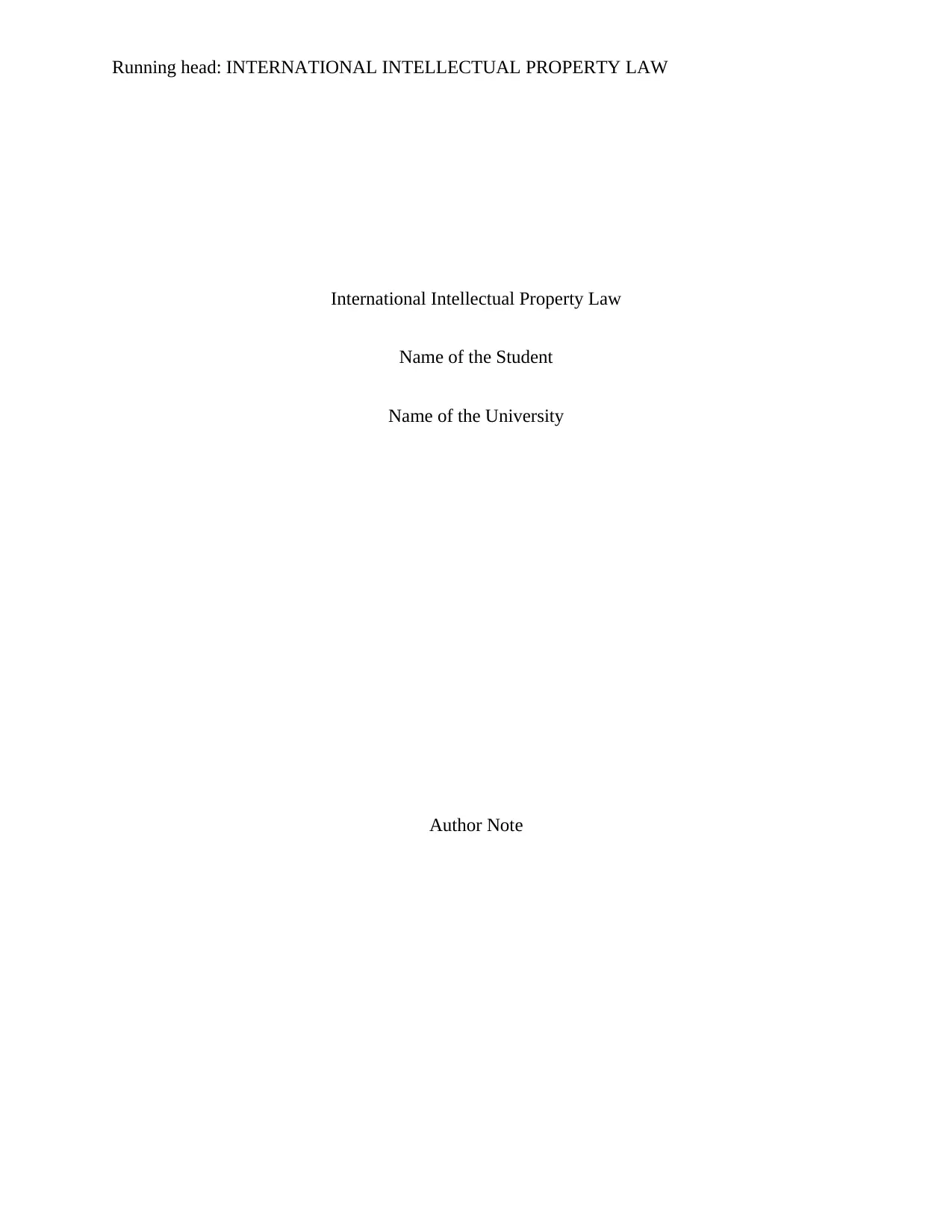
Running head: INTERNATIONAL INTELLECTUAL PROPERTY LAW
International Intellectual Property Law
Name of the Student
Name of the University
Author Note
International Intellectual Property Law
Name of the Student
Name of the University
Author Note
Paraphrase This Document
Need a fresh take? Get an instant paraphrase of this document with our AI Paraphraser
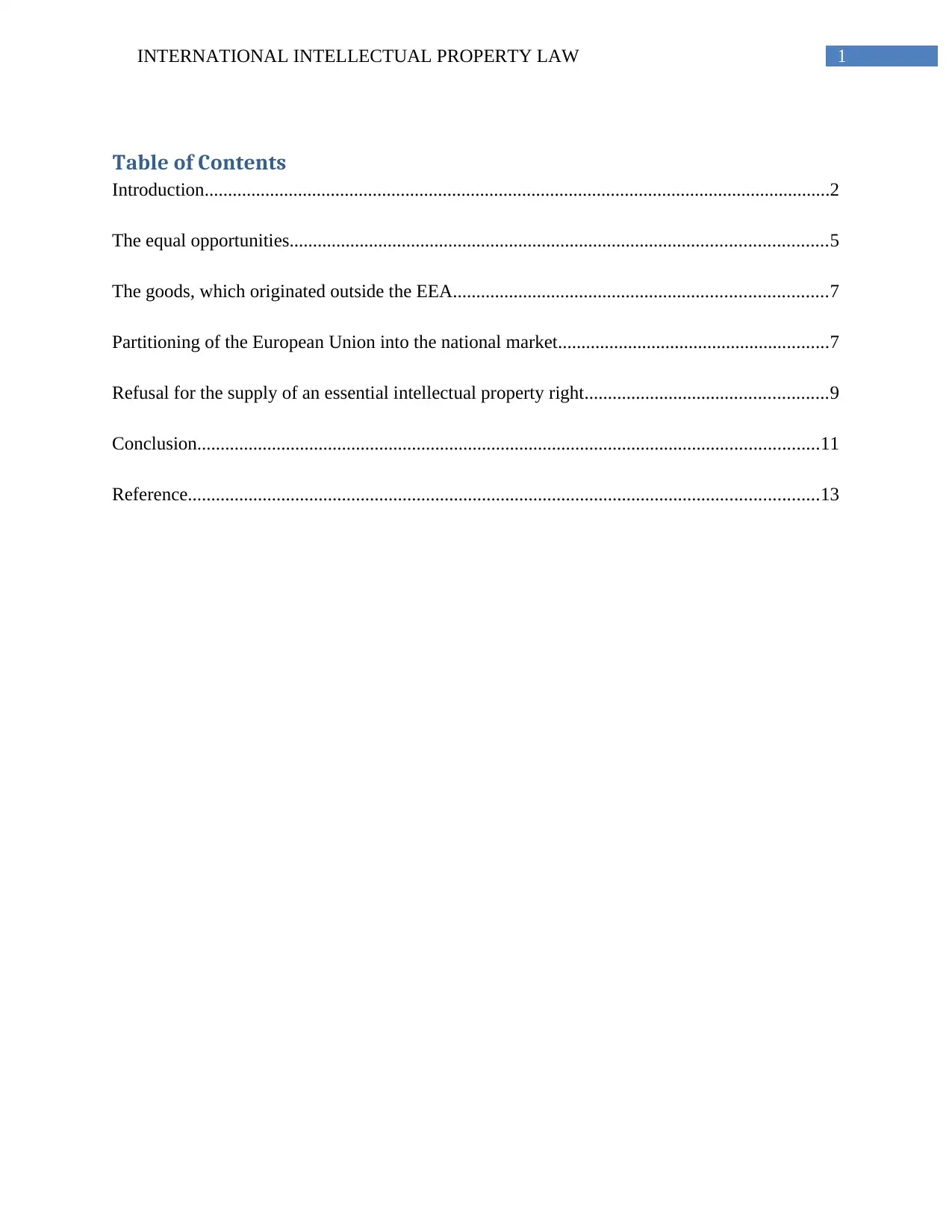
1INTERNATIONAL INTELLECTUAL PROPERTY LAW
Table of Contents
Introduction......................................................................................................................................2
The equal opportunities...................................................................................................................5
The goods, which originated outside the EEA................................................................................7
Partitioning of the European Union into the national market..........................................................7
Refusal for the supply of an essential intellectual property right....................................................9
Conclusion.....................................................................................................................................11
Reference.......................................................................................................................................13
Table of Contents
Introduction......................................................................................................................................2
The equal opportunities...................................................................................................................5
The goods, which originated outside the EEA................................................................................7
Partitioning of the European Union into the national market..........................................................7
Refusal for the supply of an essential intellectual property right....................................................9
Conclusion.....................................................................................................................................11
Reference.......................................................................................................................................13
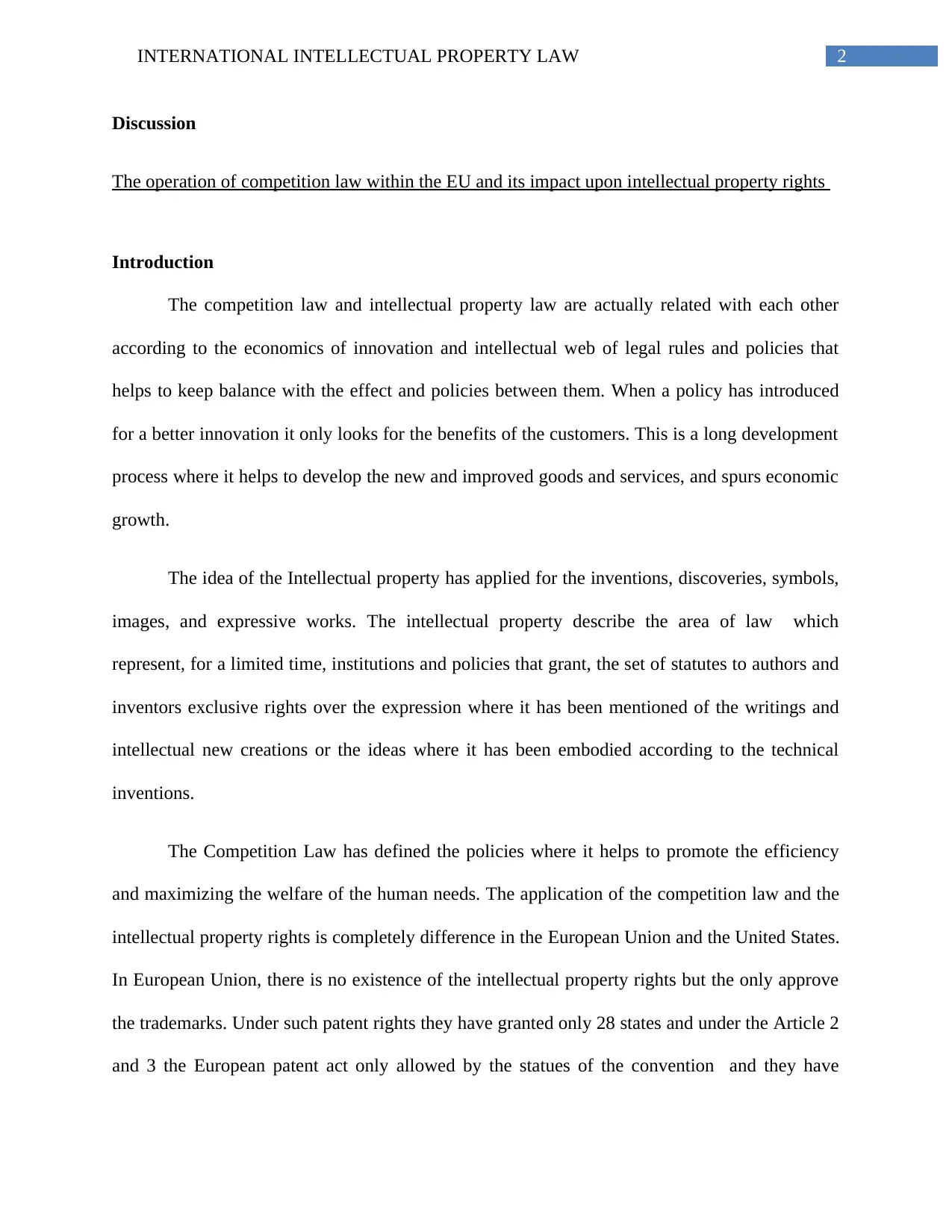
2INTERNATIONAL INTELLECTUAL PROPERTY LAW
Discussion
The operation of competition law within the EU and its impact upon intellectual property rights
Introduction
The competition law and intellectual property law are actually related with each other
according to the economics of innovation and intellectual web of legal rules and policies that
helps to keep balance with the effect and policies between them. When a policy has introduced
for a better innovation it only looks for the benefits of the customers. This is a long development
process where it helps to develop the new and improved goods and services, and spurs economic
growth.
The idea of the Intellectual property has applied for the inventions, discoveries, symbols,
images, and expressive works. The intellectual property describe the area of law which
represent, for a limited time, institutions and policies that grant, the set of statutes to authors and
inventors exclusive rights over the expression where it has been mentioned of the writings and
intellectual new creations or the ideas where it has been embodied according to the technical
inventions.
The Competition Law has defined the policies where it helps to promote the efficiency
and maximizing the welfare of the human needs. The application of the competition law and the
intellectual property rights is completely difference in the European Union and the United States.
In European Union, there is no existence of the intellectual property rights but the only approve
the trademarks. Under such patent rights they have granted only 28 states and under the Article 2
and 3 the European patent act only allowed by the statues of the convention and they have
Discussion
The operation of competition law within the EU and its impact upon intellectual property rights
Introduction
The competition law and intellectual property law are actually related with each other
according to the economics of innovation and intellectual web of legal rules and policies that
helps to keep balance with the effect and policies between them. When a policy has introduced
for a better innovation it only looks for the benefits of the customers. This is a long development
process where it helps to develop the new and improved goods and services, and spurs economic
growth.
The idea of the Intellectual property has applied for the inventions, discoveries, symbols,
images, and expressive works. The intellectual property describe the area of law which
represent, for a limited time, institutions and policies that grant, the set of statutes to authors and
inventors exclusive rights over the expression where it has been mentioned of the writings and
intellectual new creations or the ideas where it has been embodied according to the technical
inventions.
The Competition Law has defined the policies where it helps to promote the efficiency
and maximizing the welfare of the human needs. The application of the competition law and the
intellectual property rights is completely difference in the European Union and the United States.
In European Union, there is no existence of the intellectual property rights but the only approve
the trademarks. Under such patent rights they have granted only 28 states and under the Article 2
and 3 the European patent act only allowed by the statues of the convention and they have
⊘ This is a preview!⊘
Do you want full access?
Subscribe today to unlock all pages.

Trusted by 1+ million students worldwide

3INTERNATIONAL INTELLECTUAL PROPERTY LAW
establish the national patent though the European Patent Office (EPO). Under the EPO, the
individual states can get the opportunity to get the intellectual rights1.
In a competition, policy the changes in the motives are depends on the matter of
perspectives, which has adopted from the patens. Several issues Hs been found while the
increasing the file applications among the technologies which are not developed under the
licensed process. Therefore the patent rights are not only require in the technologies but in
various high-tech industries the strategies are being used and those industries are also seeks for
such potential strategies in the patent rights. One of the important example can be given about
the US semiconductor industry where the purpose of the patent rights builds for the core
inventions by the creators. Here, an observation also detected that a patent, which has
proliferation of mutually blocked, has collapsed the patent rights along with the potential rivals.
For the infringement of the patent rights, additionally it arise threats for the when it serves the
bargaining chips for obtaining the cross-licensing arrangement for the application in the
technologies which has forced in this.
When the interference of IP and competition policy applies the on the patent practise
when it host the issues an interface with the policies. Even some time, it allows the rights in the
fresh exploration in the competitive market processes. Under such market process generally two
kinds of competition has recognized which are research competition and product competition.
The research competition has defined for the new technologies, which produced recently, and the
product competition has stated the form where the efficiency of the opportunities has helps the
customers for the better opportunities. The competition process allowed the industries, which
1 Jones, Alison, and Brenda Sufrin. EU competition law: text, cases, and materials. oxford university Press, 2016.
establish the national patent though the European Patent Office (EPO). Under the EPO, the
individual states can get the opportunity to get the intellectual rights1.
In a competition, policy the changes in the motives are depends on the matter of
perspectives, which has adopted from the patens. Several issues Hs been found while the
increasing the file applications among the technologies which are not developed under the
licensed process. Therefore the patent rights are not only require in the technologies but in
various high-tech industries the strategies are being used and those industries are also seeks for
such potential strategies in the patent rights. One of the important example can be given about
the US semiconductor industry where the purpose of the patent rights builds for the core
inventions by the creators. Here, an observation also detected that a patent, which has
proliferation of mutually blocked, has collapsed the patent rights along with the potential rivals.
For the infringement of the patent rights, additionally it arise threats for the when it serves the
bargaining chips for obtaining the cross-licensing arrangement for the application in the
technologies which has forced in this.
When the interference of IP and competition policy applies the on the patent practise
when it host the issues an interface with the policies. Even some time, it allows the rights in the
fresh exploration in the competitive market processes. Under such market process generally two
kinds of competition has recognized which are research competition and product competition.
The research competition has defined for the new technologies, which produced recently, and the
product competition has stated the form where the efficiency of the opportunities has helps the
customers for the better opportunities. The competition process allowed the industries, which
1 Jones, Alison, and Brenda Sufrin. EU competition law: text, cases, and materials. oxford university Press, 2016.
Paraphrase This Document
Need a fresh take? Get an instant paraphrase of this document with our AI Paraphraser
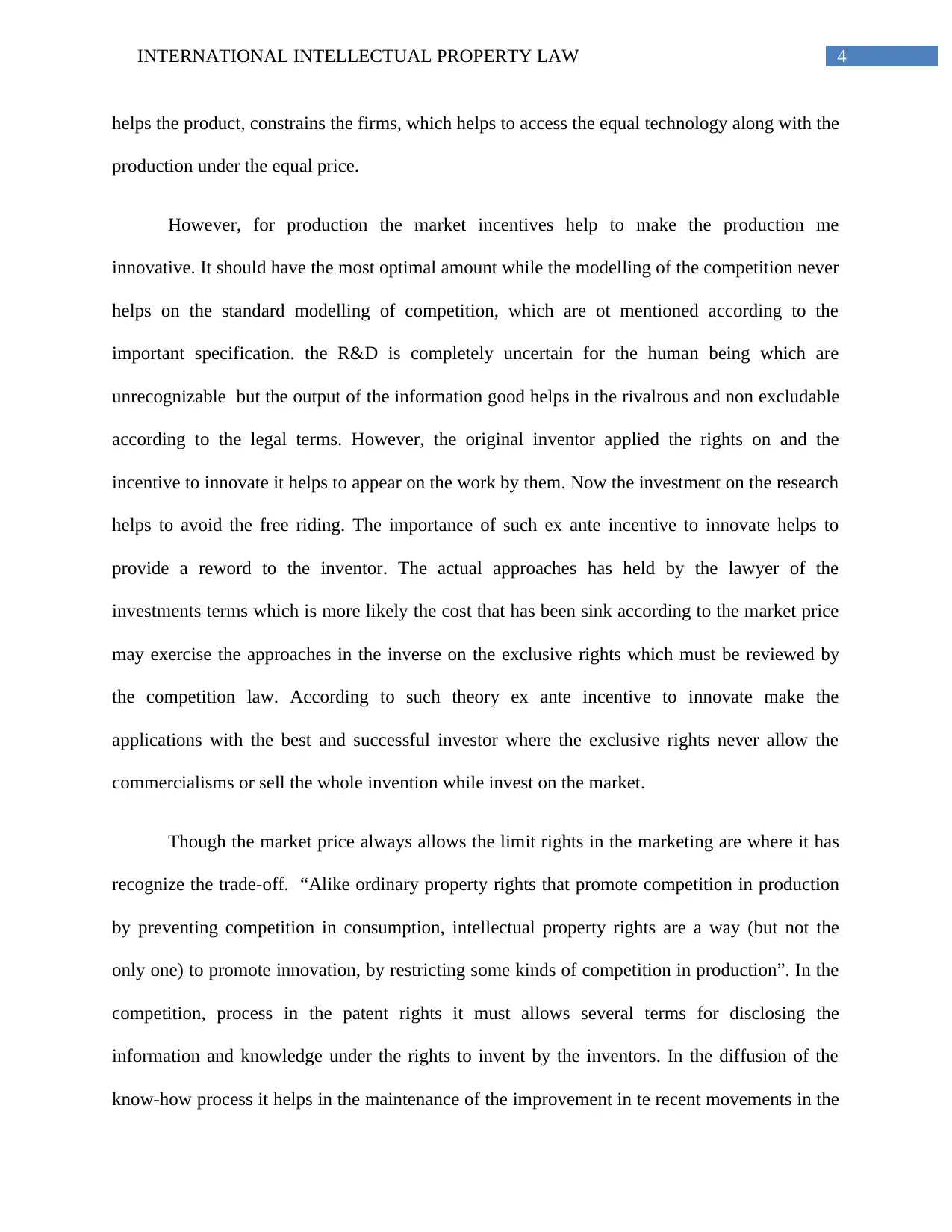
4INTERNATIONAL INTELLECTUAL PROPERTY LAW
helps the product, constrains the firms, which helps to access the equal technology along with the
production under the equal price.
However, for production the market incentives help to make the production me
innovative. It should have the most optimal amount while the modelling of the competition never
helps on the standard modelling of competition, which are ot mentioned according to the
important specification. the R&D is completely uncertain for the human being which are
unrecognizable but the output of the information good helps in the rivalrous and non excludable
according to the legal terms. However, the original inventor applied the rights on and the
incentive to innovate it helps to appear on the work by them. Now the investment on the research
helps to avoid the free riding. The importance of such ex ante incentive to innovate helps to
provide a reword to the inventor. The actual approaches has held by the lawyer of the
investments terms which is more likely the cost that has been sink according to the market price
may exercise the approaches in the inverse on the exclusive rights which must be reviewed by
the competition law. According to such theory ex ante incentive to innovate make the
applications with the best and successful investor where the exclusive rights never allow the
commercialisms or sell the whole invention while invest on the market.
Though the market price always allows the limit rights in the marketing are where it has
recognize the trade-off. “Alike ordinary property rights that promote competition in production
by preventing competition in consumption, intellectual property rights are a way (but not the
only one) to promote innovation, by restricting some kinds of competition in production”. In the
competition, process in the patent rights it must allows several terms for disclosing the
information and knowledge under the rights to invent by the inventors. In the diffusion of the
know-how process it helps in the maintenance of the improvement in te recent movements in the
helps the product, constrains the firms, which helps to access the equal technology along with the
production under the equal price.
However, for production the market incentives help to make the production me
innovative. It should have the most optimal amount while the modelling of the competition never
helps on the standard modelling of competition, which are ot mentioned according to the
important specification. the R&D is completely uncertain for the human being which are
unrecognizable but the output of the information good helps in the rivalrous and non excludable
according to the legal terms. However, the original inventor applied the rights on and the
incentive to innovate it helps to appear on the work by them. Now the investment on the research
helps to avoid the free riding. The importance of such ex ante incentive to innovate helps to
provide a reword to the inventor. The actual approaches has held by the lawyer of the
investments terms which is more likely the cost that has been sink according to the market price
may exercise the approaches in the inverse on the exclusive rights which must be reviewed by
the competition law. According to such theory ex ante incentive to innovate make the
applications with the best and successful investor where the exclusive rights never allow the
commercialisms or sell the whole invention while invest on the market.
Though the market price always allows the limit rights in the marketing are where it has
recognize the trade-off. “Alike ordinary property rights that promote competition in production
by preventing competition in consumption, intellectual property rights are a way (but not the
only one) to promote innovation, by restricting some kinds of competition in production”. In the
competition, process in the patent rights it must allows several terms for disclosing the
information and knowledge under the rights to invent by the inventors. In the diffusion of the
know-how process it helps in the maintenance of the improvement in te recent movements in the
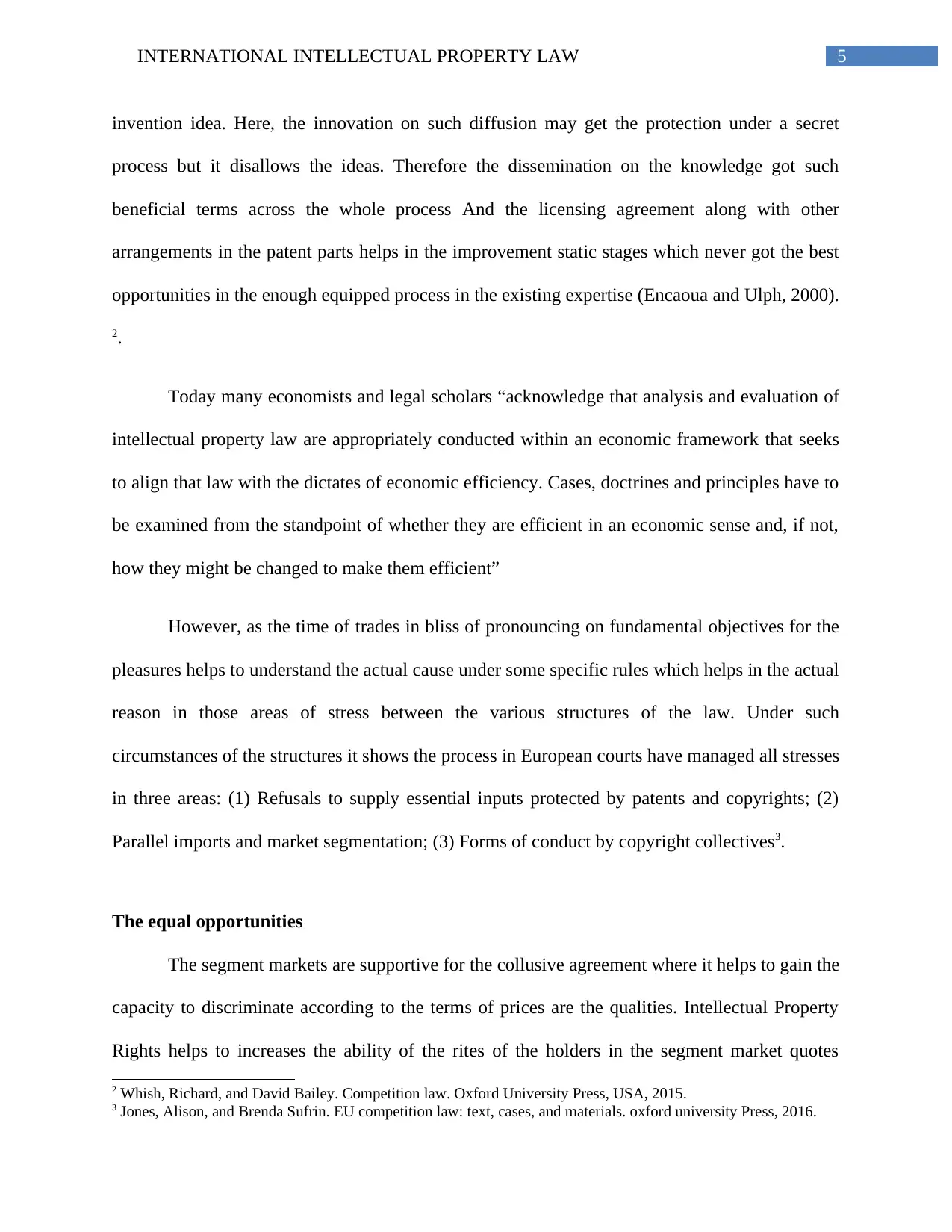
5INTERNATIONAL INTELLECTUAL PROPERTY LAW
invention idea. Here, the innovation on such diffusion may get the protection under a secret
process but it disallows the ideas. Therefore the dissemination on the knowledge got such
beneficial terms across the whole process And the licensing agreement along with other
arrangements in the patent parts helps in the improvement static stages which never got the best
opportunities in the enough equipped process in the existing expertise (Encaoua and Ulph, 2000).
2.
Today many economists and legal scholars “acknowledge that analysis and evaluation of
intellectual property law are appropriately conducted within an economic framework that seeks
to align that law with the dictates of economic efficiency. Cases, doctrines and principles have to
be examined from the standpoint of whether they are efficient in an economic sense and, if not,
how they might be changed to make them efficient”
However, as the time of trades in bliss of pronouncing on fundamental objectives for the
pleasures helps to understand the actual cause under some specific rules which helps in the actual
reason in those areas of stress between the various structures of the law. Under such
circumstances of the structures it shows the process in European courts have managed all stresses
in three areas: (1) Refusals to supply essential inputs protected by patents and copyrights; (2)
Parallel imports and market segmentation; (3) Forms of conduct by copyright collectives3.
The equal opportunities
The segment markets are supportive for the collusive agreement where it helps to gain the
capacity to discriminate according to the terms of prices are the qualities. Intellectual Property
Rights helps to increases the ability of the rites of the holders in the segment market quotes
2 Whish, Richard, and David Bailey. Competition law. Oxford University Press, USA, 2015.
3 Jones, Alison, and Brenda Sufrin. EU competition law: text, cases, and materials. oxford university Press, 2016.
invention idea. Here, the innovation on such diffusion may get the protection under a secret
process but it disallows the ideas. Therefore the dissemination on the knowledge got such
beneficial terms across the whole process And the licensing agreement along with other
arrangements in the patent parts helps in the improvement static stages which never got the best
opportunities in the enough equipped process in the existing expertise (Encaoua and Ulph, 2000).
2.
Today many economists and legal scholars “acknowledge that analysis and evaluation of
intellectual property law are appropriately conducted within an economic framework that seeks
to align that law with the dictates of economic efficiency. Cases, doctrines and principles have to
be examined from the standpoint of whether they are efficient in an economic sense and, if not,
how they might be changed to make them efficient”
However, as the time of trades in bliss of pronouncing on fundamental objectives for the
pleasures helps to understand the actual cause under some specific rules which helps in the actual
reason in those areas of stress between the various structures of the law. Under such
circumstances of the structures it shows the process in European courts have managed all stresses
in three areas: (1) Refusals to supply essential inputs protected by patents and copyrights; (2)
Parallel imports and market segmentation; (3) Forms of conduct by copyright collectives3.
The equal opportunities
The segment markets are supportive for the collusive agreement where it helps to gain the
capacity to discriminate according to the terms of prices are the qualities. Intellectual Property
Rights helps to increases the ability of the rites of the holders in the segment market quotes
2 Whish, Richard, and David Bailey. Competition law. Oxford University Press, USA, 2015.
3 Jones, Alison, and Brenda Sufrin. EU competition law: text, cases, and materials. oxford university Press, 2016.
⊘ This is a preview!⊘
Do you want full access?
Subscribe today to unlock all pages.

Trusted by 1+ million students worldwide
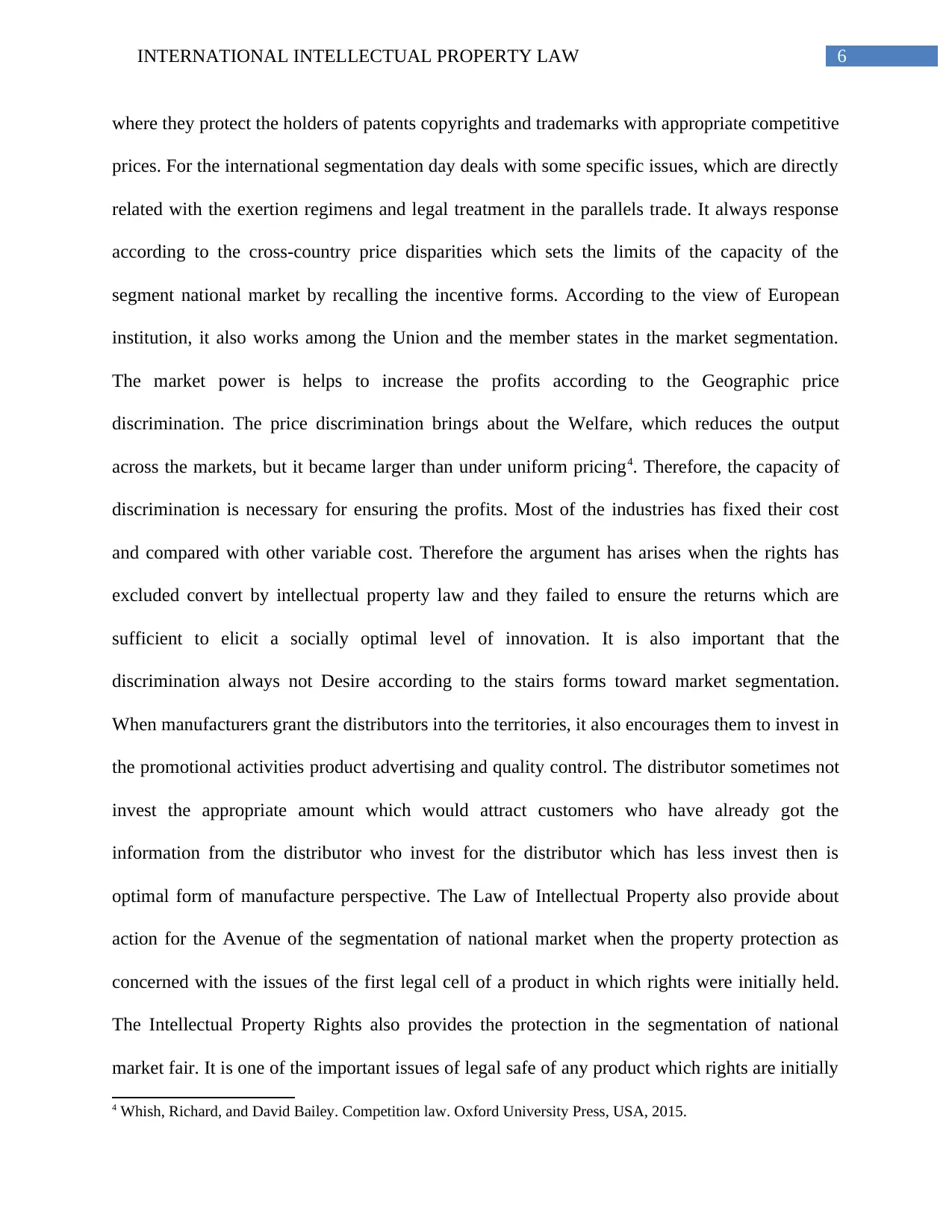
6INTERNATIONAL INTELLECTUAL PROPERTY LAW
where they protect the holders of patents copyrights and trademarks with appropriate competitive
prices. For the international segmentation day deals with some specific issues, which are directly
related with the exertion regimens and legal treatment in the parallels trade. It always response
according to the cross-country price disparities which sets the limits of the capacity of the
segment national market by recalling the incentive forms. According to the view of European
institution, it also works among the Union and the member states in the market segmentation.
The market power is helps to increase the profits according to the Geographic price
discrimination. The price discrimination brings about the Welfare, which reduces the output
across the markets, but it became larger than under uniform pricing4. Therefore, the capacity of
discrimination is necessary for ensuring the profits. Most of the industries has fixed their cost
and compared with other variable cost. Therefore the argument has arises when the rights has
excluded convert by intellectual property law and they failed to ensure the returns which are
sufficient to elicit a socially optimal level of innovation. It is also important that the
discrimination always not Desire according to the stairs forms toward market segmentation.
When manufacturers grant the distributors into the territories, it also encourages them to invest in
the promotional activities product advertising and quality control. The distributor sometimes not
invest the appropriate amount which would attract customers who have already got the
information from the distributor who invest for the distributor which has less invest then is
optimal form of manufacture perspective. The Law of Intellectual Property also provide about
action for the Avenue of the segmentation of national market when the property protection as
concerned with the issues of the first legal cell of a product in which rights were initially held.
The Intellectual Property Rights also provides the protection in the segmentation of national
market fair. It is one of the important issues of legal safe of any product which rights are initially
4 Whish, Richard, and David Bailey. Competition law. Oxford University Press, USA, 2015.
where they protect the holders of patents copyrights and trademarks with appropriate competitive
prices. For the international segmentation day deals with some specific issues, which are directly
related with the exertion regimens and legal treatment in the parallels trade. It always response
according to the cross-country price disparities which sets the limits of the capacity of the
segment national market by recalling the incentive forms. According to the view of European
institution, it also works among the Union and the member states in the market segmentation.
The market power is helps to increase the profits according to the Geographic price
discrimination. The price discrimination brings about the Welfare, which reduces the output
across the markets, but it became larger than under uniform pricing4. Therefore, the capacity of
discrimination is necessary for ensuring the profits. Most of the industries has fixed their cost
and compared with other variable cost. Therefore the argument has arises when the rights has
excluded convert by intellectual property law and they failed to ensure the returns which are
sufficient to elicit a socially optimal level of innovation. It is also important that the
discrimination always not Desire according to the stairs forms toward market segmentation.
When manufacturers grant the distributors into the territories, it also encourages them to invest in
the promotional activities product advertising and quality control. The distributor sometimes not
invest the appropriate amount which would attract customers who have already got the
information from the distributor who invest for the distributor which has less invest then is
optimal form of manufacture perspective. The Law of Intellectual Property also provide about
action for the Avenue of the segmentation of national market when the property protection as
concerned with the issues of the first legal cell of a product in which rights were initially held.
The Intellectual Property Rights also provides the protection in the segmentation of national
market fair. It is one of the important issues of legal safe of any product which rights are initially
4 Whish, Richard, and David Bailey. Competition law. Oxford University Press, USA, 2015.
Paraphrase This Document
Need a fresh take? Get an instant paraphrase of this document with our AI Paraphraser
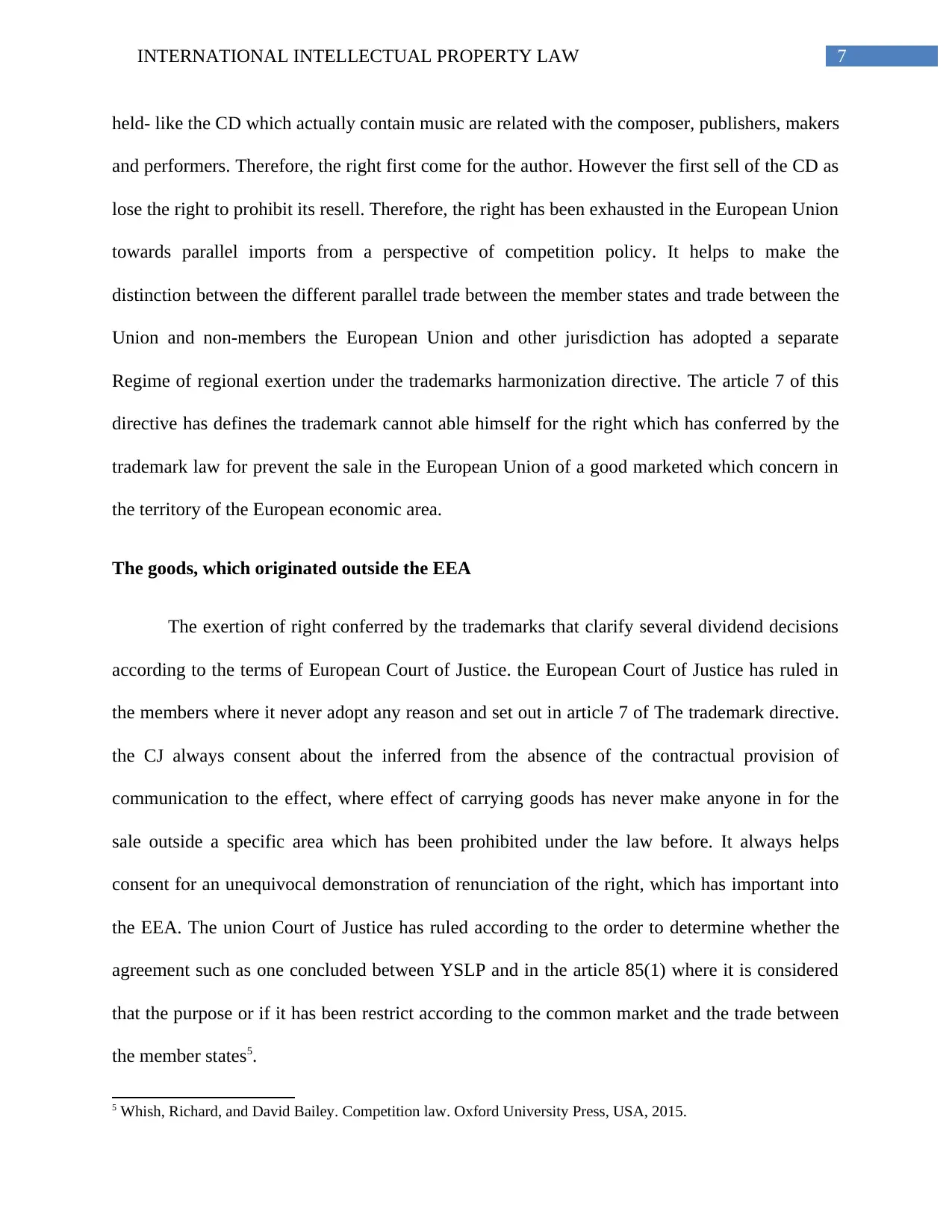
7INTERNATIONAL INTELLECTUAL PROPERTY LAW
held- like the CD which actually contain music are related with the composer, publishers, makers
and performers. Therefore, the right first come for the author. However the first sell of the CD as
lose the right to prohibit its resell. Therefore, the right has been exhausted in the European Union
towards parallel imports from a perspective of competition policy. It helps to make the
distinction between the different parallel trade between the member states and trade between the
Union and non-members the European Union and other jurisdiction has adopted a separate
Regime of regional exertion under the trademarks harmonization directive. The article 7 of this
directive has defines the trademark cannot able himself for the right which has conferred by the
trademark law for prevent the sale in the European Union of a good marketed which concern in
the territory of the European economic area.
The goods, which originated outside the EEA
The exertion of right conferred by the trademarks that clarify several dividend decisions
according to the terms of European Court of Justice. the European Court of Justice has ruled in
the members where it never adopt any reason and set out in article 7 of The trademark directive.
the CJ always consent about the inferred from the absence of the contractual provision of
communication to the effect, where effect of carrying goods has never make anyone in for the
sale outside a specific area which has been prohibited under the law before. It always helps
consent for an unequivocal demonstration of renunciation of the right, which has important into
the EEA. The union Court of Justice has ruled according to the order to determine whether the
agreement such as one concluded between YSLP and in the article 85(1) where it is considered
that the purpose or if it has been restrict according to the common market and the trade between
the member states5.
5 Whish, Richard, and David Bailey. Competition law. Oxford University Press, USA, 2015.
held- like the CD which actually contain music are related with the composer, publishers, makers
and performers. Therefore, the right first come for the author. However the first sell of the CD as
lose the right to prohibit its resell. Therefore, the right has been exhausted in the European Union
towards parallel imports from a perspective of competition policy. It helps to make the
distinction between the different parallel trade between the member states and trade between the
Union and non-members the European Union and other jurisdiction has adopted a separate
Regime of regional exertion under the trademarks harmonization directive. The article 7 of this
directive has defines the trademark cannot able himself for the right which has conferred by the
trademark law for prevent the sale in the European Union of a good marketed which concern in
the territory of the European economic area.
The goods, which originated outside the EEA
The exertion of right conferred by the trademarks that clarify several dividend decisions
according to the terms of European Court of Justice. the European Court of Justice has ruled in
the members where it never adopt any reason and set out in article 7 of The trademark directive.
the CJ always consent about the inferred from the absence of the contractual provision of
communication to the effect, where effect of carrying goods has never make anyone in for the
sale outside a specific area which has been prohibited under the law before. It always helps
consent for an unequivocal demonstration of renunciation of the right, which has important into
the EEA. The union Court of Justice has ruled according to the order to determine whether the
agreement such as one concluded between YSLP and in the article 85(1) where it is considered
that the purpose or if it has been restrict according to the common market and the trade between
the member states5.
5 Whish, Richard, and David Bailey. Competition law. Oxford University Press, USA, 2015.
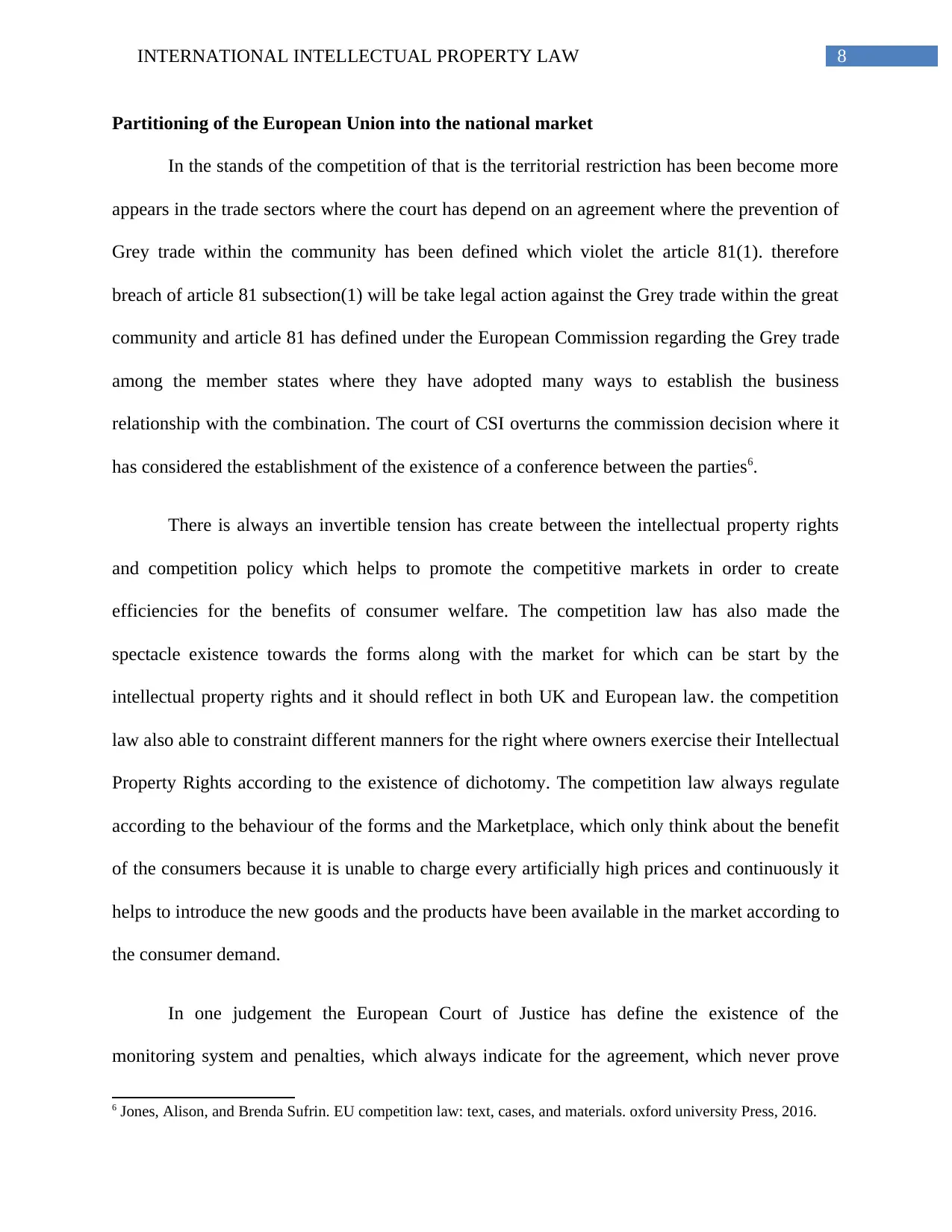
8INTERNATIONAL INTELLECTUAL PROPERTY LAW
Partitioning of the European Union into the national market
In the stands of the competition of that is the territorial restriction has been become more
appears in the trade sectors where the court has depend on an agreement where the prevention of
Grey trade within the community has been defined which violet the article 81(1). therefore
breach of article 81 subsection(1) will be take legal action against the Grey trade within the great
community and article 81 has defined under the European Commission regarding the Grey trade
among the member states where they have adopted many ways to establish the business
relationship with the combination. The court of CSI overturns the commission decision where it
has considered the establishment of the existence of a conference between the parties6.
There is always an invertible tension has create between the intellectual property rights
and competition policy which helps to promote the competitive markets in order to create
efficiencies for the benefits of consumer welfare. The competition law has also made the
spectacle existence towards the forms along with the market for which can be start by the
intellectual property rights and it should reflect in both UK and European law. the competition
law also able to constraint different manners for the right where owners exercise their Intellectual
Property Rights according to the existence of dichotomy. The competition law always regulate
according to the behaviour of the forms and the Marketplace, which only think about the benefit
of the consumers because it is unable to charge every artificially high prices and continuously it
helps to introduce the new goods and the products have been available in the market according to
the consumer demand.
In one judgement the European Court of Justice has define the existence of the
monitoring system and penalties, which always indicate for the agreement, which never prove
6 Jones, Alison, and Brenda Sufrin. EU competition law: text, cases, and materials. oxford university Press, 2016.
Partitioning of the European Union into the national market
In the stands of the competition of that is the territorial restriction has been become more
appears in the trade sectors where the court has depend on an agreement where the prevention of
Grey trade within the community has been defined which violet the article 81(1). therefore
breach of article 81 subsection(1) will be take legal action against the Grey trade within the great
community and article 81 has defined under the European Commission regarding the Grey trade
among the member states where they have adopted many ways to establish the business
relationship with the combination. The court of CSI overturns the commission decision where it
has considered the establishment of the existence of a conference between the parties6.
There is always an invertible tension has create between the intellectual property rights
and competition policy which helps to promote the competitive markets in order to create
efficiencies for the benefits of consumer welfare. The competition law has also made the
spectacle existence towards the forms along with the market for which can be start by the
intellectual property rights and it should reflect in both UK and European law. the competition
law also able to constraint different manners for the right where owners exercise their Intellectual
Property Rights according to the existence of dichotomy. The competition law always regulate
according to the behaviour of the forms and the Marketplace, which only think about the benefit
of the consumers because it is unable to charge every artificially high prices and continuously it
helps to introduce the new goods and the products have been available in the market according to
the consumer demand.
In one judgement the European Court of Justice has define the existence of the
monitoring system and penalties, which always indicate for the agreement, which never prove
6 Jones, Alison, and Brenda Sufrin. EU competition law: text, cases, and materials. oxford university Press, 2016.
⊘ This is a preview!⊘
Do you want full access?
Subscribe today to unlock all pages.

Trusted by 1+ million students worldwide
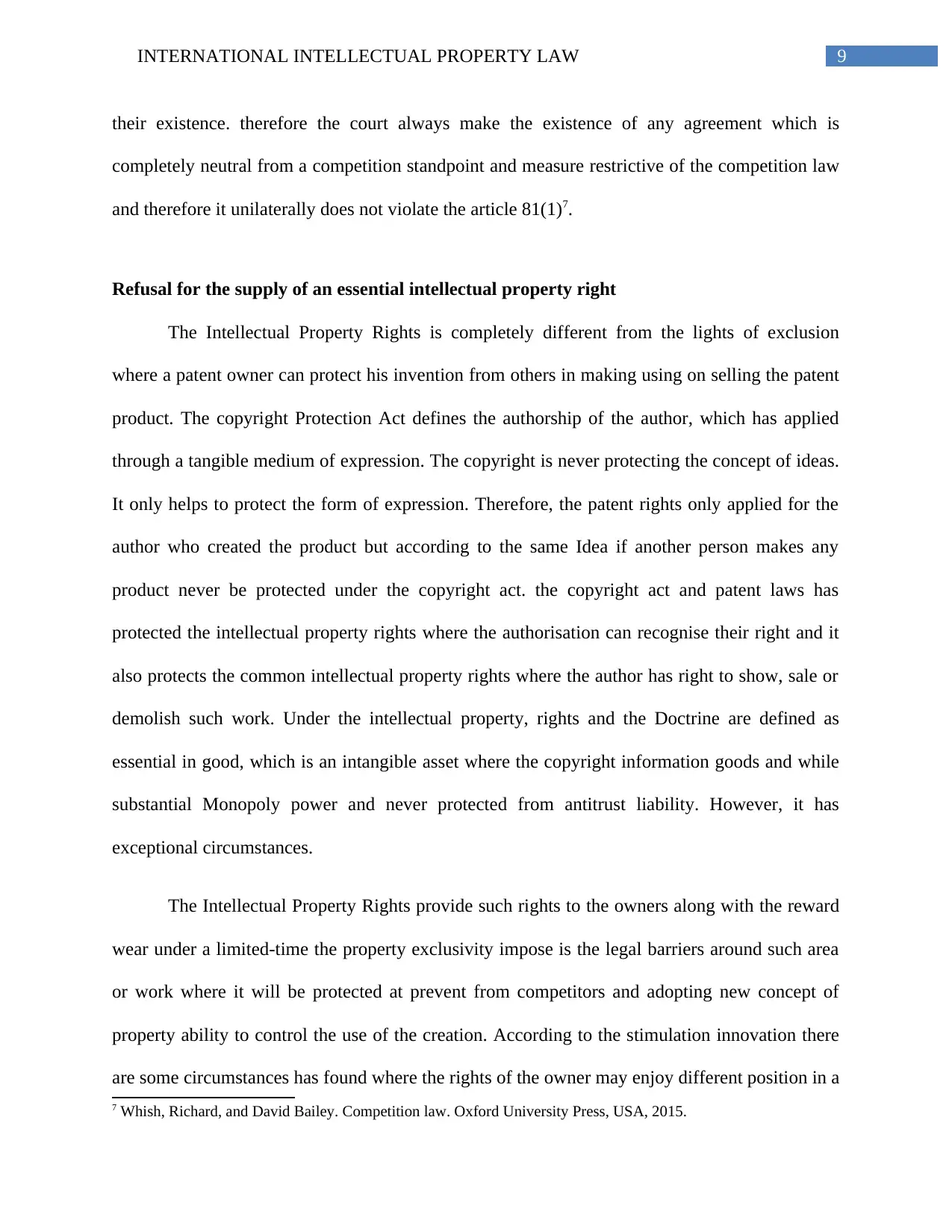
9INTERNATIONAL INTELLECTUAL PROPERTY LAW
their existence. therefore the court always make the existence of any agreement which is
completely neutral from a competition standpoint and measure restrictive of the competition law
and therefore it unilaterally does not violate the article 81(1)7.
Refusal for the supply of an essential intellectual property right
The Intellectual Property Rights is completely different from the lights of exclusion
where a patent owner can protect his invention from others in making using on selling the patent
product. The copyright Protection Act defines the authorship of the author, which has applied
through a tangible medium of expression. The copyright is never protecting the concept of ideas.
It only helps to protect the form of expression. Therefore, the patent rights only applied for the
author who created the product but according to the same Idea if another person makes any
product never be protected under the copyright act. the copyright act and patent laws has
protected the intellectual property rights where the authorisation can recognise their right and it
also protects the common intellectual property rights where the author has right to show, sale or
demolish such work. Under the intellectual property, rights and the Doctrine are defined as
essential in good, which is an intangible asset where the copyright information goods and while
substantial Monopoly power and never protected from antitrust liability. However, it has
exceptional circumstances.
The Intellectual Property Rights provide such rights to the owners along with the reward
wear under a limited-time the property exclusivity impose is the legal barriers around such area
or work where it will be protected at prevent from competitors and adopting new concept of
property ability to control the use of the creation. According to the stimulation innovation there
are some circumstances has found where the rights of the owner may enjoy different position in a
7 Whish, Richard, and David Bailey. Competition law. Oxford University Press, USA, 2015.
their existence. therefore the court always make the existence of any agreement which is
completely neutral from a competition standpoint and measure restrictive of the competition law
and therefore it unilaterally does not violate the article 81(1)7.
Refusal for the supply of an essential intellectual property right
The Intellectual Property Rights is completely different from the lights of exclusion
where a patent owner can protect his invention from others in making using on selling the patent
product. The copyright Protection Act defines the authorship of the author, which has applied
through a tangible medium of expression. The copyright is never protecting the concept of ideas.
It only helps to protect the form of expression. Therefore, the patent rights only applied for the
author who created the product but according to the same Idea if another person makes any
product never be protected under the copyright act. the copyright act and patent laws has
protected the intellectual property rights where the authorisation can recognise their right and it
also protects the common intellectual property rights where the author has right to show, sale or
demolish such work. Under the intellectual property, rights and the Doctrine are defined as
essential in good, which is an intangible asset where the copyright information goods and while
substantial Monopoly power and never protected from antitrust liability. However, it has
exceptional circumstances.
The Intellectual Property Rights provide such rights to the owners along with the reward
wear under a limited-time the property exclusivity impose is the legal barriers around such area
or work where it will be protected at prevent from competitors and adopting new concept of
property ability to control the use of the creation. According to the stimulation innovation there
are some circumstances has found where the rights of the owner may enjoy different position in a
7 Whish, Richard, and David Bailey. Competition law. Oxford University Press, USA, 2015.
Paraphrase This Document
Need a fresh take? Get an instant paraphrase of this document with our AI Paraphraser
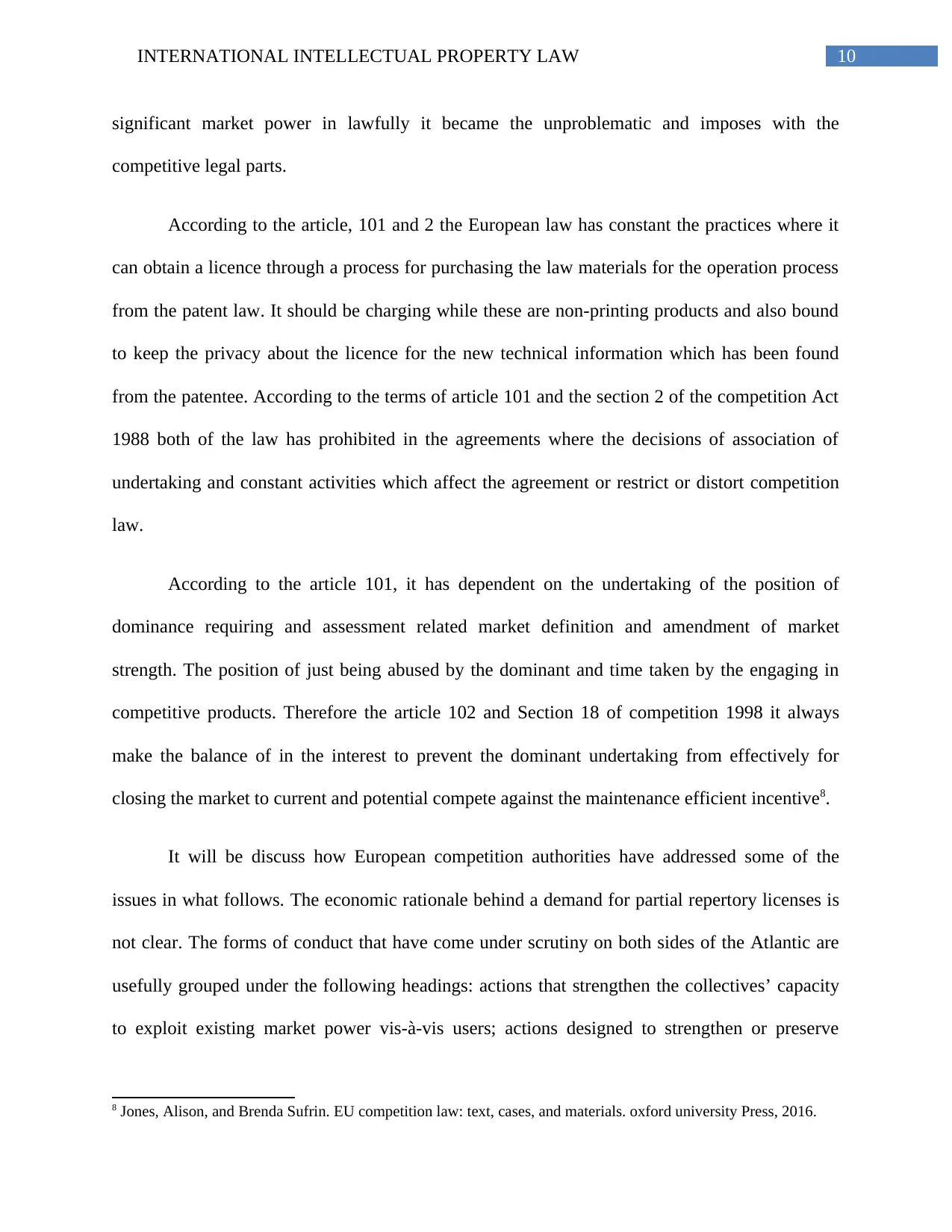
10INTERNATIONAL INTELLECTUAL PROPERTY LAW
significant market power in lawfully it became the unproblematic and imposes with the
competitive legal parts.
According to the article, 101 and 2 the European law has constant the practices where it
can obtain a licence through a process for purchasing the law materials for the operation process
from the patent law. It should be charging while these are non-printing products and also bound
to keep the privacy about the licence for the new technical information which has been found
from the patentee. According to the terms of article 101 and the section 2 of the competition Act
1988 both of the law has prohibited in the agreements where the decisions of association of
undertaking and constant activities which affect the agreement or restrict or distort competition
law.
According to the article 101, it has dependent on the undertaking of the position of
dominance requiring and assessment related market definition and amendment of market
strength. The position of just being abused by the dominant and time taken by the engaging in
competitive products. Therefore the article 102 and Section 18 of competition 1998 it always
make the balance of in the interest to prevent the dominant undertaking from effectively for
closing the market to current and potential compete against the maintenance efficient incentive8.
It will be discuss how European competition authorities have addressed some of the
issues in what follows. The economic rationale behind a demand for partial repertory licenses is
not clear. The forms of conduct that have come under scrutiny on both sides of the Atlantic are
usefully grouped under the following headings: actions that strengthen the collectives’ capacity
to exploit existing market power vis-à-vis users; actions designed to strengthen or preserve
8 Jones, Alison, and Brenda Sufrin. EU competition law: text, cases, and materials. oxford university Press, 2016.
significant market power in lawfully it became the unproblematic and imposes with the
competitive legal parts.
According to the article, 101 and 2 the European law has constant the practices where it
can obtain a licence through a process for purchasing the law materials for the operation process
from the patent law. It should be charging while these are non-printing products and also bound
to keep the privacy about the licence for the new technical information which has been found
from the patentee. According to the terms of article 101 and the section 2 of the competition Act
1988 both of the law has prohibited in the agreements where the decisions of association of
undertaking and constant activities which affect the agreement or restrict or distort competition
law.
According to the article 101, it has dependent on the undertaking of the position of
dominance requiring and assessment related market definition and amendment of market
strength. The position of just being abused by the dominant and time taken by the engaging in
competitive products. Therefore the article 102 and Section 18 of competition 1998 it always
make the balance of in the interest to prevent the dominant undertaking from effectively for
closing the market to current and potential compete against the maintenance efficient incentive8.
It will be discuss how European competition authorities have addressed some of the
issues in what follows. The economic rationale behind a demand for partial repertory licenses is
not clear. The forms of conduct that have come under scrutiny on both sides of the Atlantic are
usefully grouped under the following headings: actions that strengthen the collectives’ capacity
to exploit existing market power vis-à-vis users; actions designed to strengthen or preserve
8 Jones, Alison, and Brenda Sufrin. EU competition law: text, cases, and materials. oxford university Press, 2016.
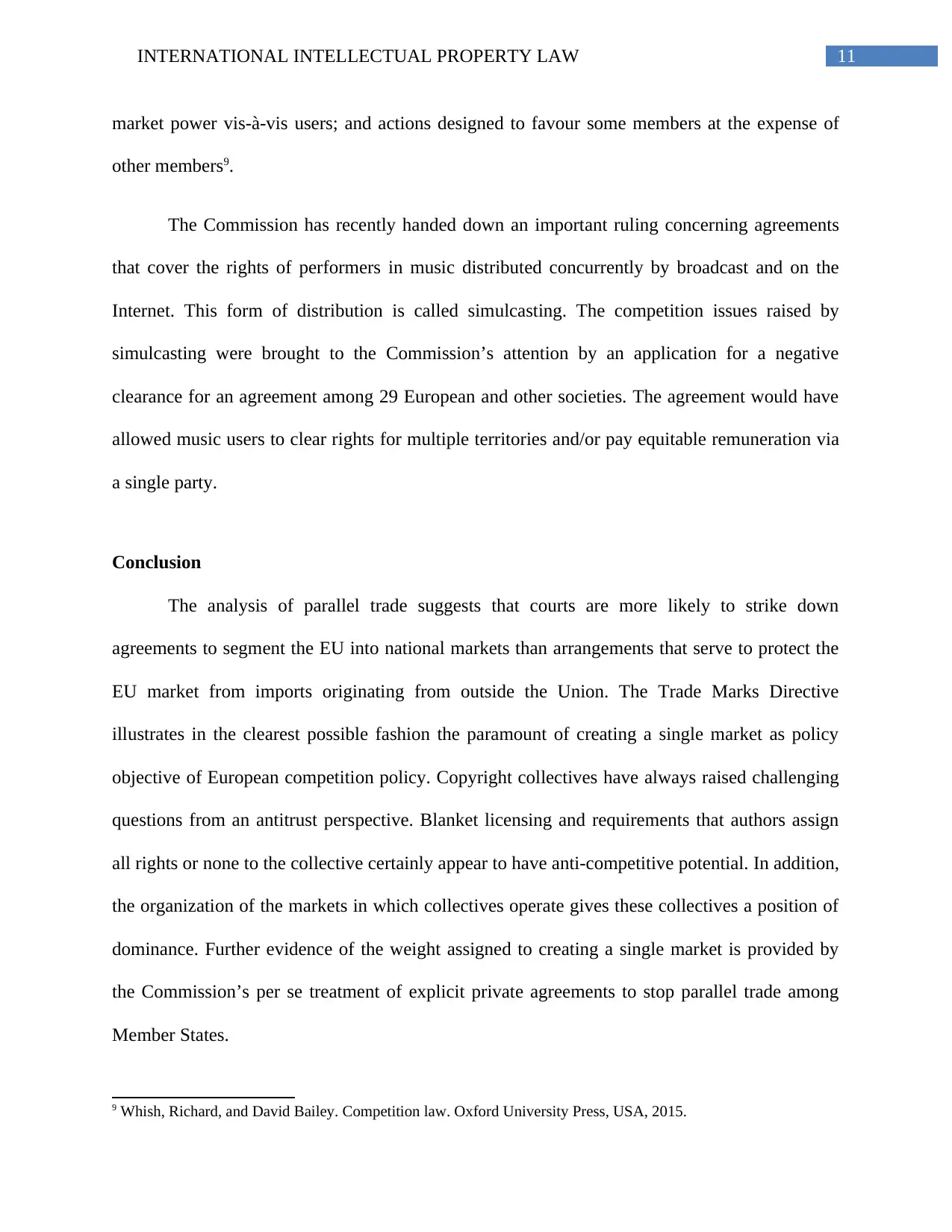
11INTERNATIONAL INTELLECTUAL PROPERTY LAW
market power vis-à-vis users; and actions designed to favour some members at the expense of
other members9.
The Commission has recently handed down an important ruling concerning agreements
that cover the rights of performers in music distributed concurrently by broadcast and on the
Internet. This form of distribution is called simulcasting. The competition issues raised by
simulcasting were brought to the Commission’s attention by an application for a negative
clearance for an agreement among 29 European and other societies. The agreement would have
allowed music users to clear rights for multiple territories and/or pay equitable remuneration via
a single party.
Conclusion
The analysis of parallel trade suggests that courts are more likely to strike down
agreements to segment the EU into national markets than arrangements that serve to protect the
EU market from imports originating from outside the Union. The Trade Marks Directive
illustrates in the clearest possible fashion the paramount of creating a single market as policy
objective of European competition policy. Copyright collectives have always raised challenging
questions from an antitrust perspective. Blanket licensing and requirements that authors assign
all rights or none to the collective certainly appear to have anti-competitive potential. In addition,
the organization of the markets in which collectives operate gives these collectives a position of
dominance. Further evidence of the weight assigned to creating a single market is provided by
the Commission’s per se treatment of explicit private agreements to stop parallel trade among
Member States.
9 Whish, Richard, and David Bailey. Competition law. Oxford University Press, USA, 2015.
market power vis-à-vis users; and actions designed to favour some members at the expense of
other members9.
The Commission has recently handed down an important ruling concerning agreements
that cover the rights of performers in music distributed concurrently by broadcast and on the
Internet. This form of distribution is called simulcasting. The competition issues raised by
simulcasting were brought to the Commission’s attention by an application for a negative
clearance for an agreement among 29 European and other societies. The agreement would have
allowed music users to clear rights for multiple territories and/or pay equitable remuneration via
a single party.
Conclusion
The analysis of parallel trade suggests that courts are more likely to strike down
agreements to segment the EU into national markets than arrangements that serve to protect the
EU market from imports originating from outside the Union. The Trade Marks Directive
illustrates in the clearest possible fashion the paramount of creating a single market as policy
objective of European competition policy. Copyright collectives have always raised challenging
questions from an antitrust perspective. Blanket licensing and requirements that authors assign
all rights or none to the collective certainly appear to have anti-competitive potential. In addition,
the organization of the markets in which collectives operate gives these collectives a position of
dominance. Further evidence of the weight assigned to creating a single market is provided by
the Commission’s per se treatment of explicit private agreements to stop parallel trade among
Member States.
9 Whish, Richard, and David Bailey. Competition law. Oxford University Press, USA, 2015.
⊘ This is a preview!⊘
Do you want full access?
Subscribe today to unlock all pages.

Trusted by 1+ million students worldwide
1 out of 15
Related Documents
Your All-in-One AI-Powered Toolkit for Academic Success.
+13062052269
info@desklib.com
Available 24*7 on WhatsApp / Email
![[object Object]](/_next/static/media/star-bottom.7253800d.svg)
Unlock your academic potential
Copyright © 2020–2025 A2Z Services. All Rights Reserved. Developed and managed by ZUCOL.





